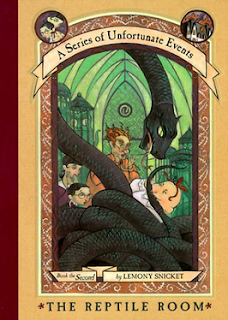Find a Review
Book reviews from Robin, co-host of the Books That Burn podcast. Bookshop links are affiliate links, we may receive a small commission if you purchase from our Bookshop. This content is CAN credentialed, which means you can report instances of harassment, abuse, or other harm on their hotline at (617) 249-4255, or on their website at creatoraccountabilitynetwork.org.
Featured
- Get link
- X
- Other Apps
The Reptile Room by Lemony Snicket (A Series of Unfortunate Events #2)
Violet, Klaus, and Sunny Baudelaire are intelligent children. They are charming, and resourceful, and have pleasant facial features. Unfortunately, they are exceptionally unlucky.
In the first two books alone, the three youngsters encounter a greedy and repulsive villain, itchy clothing, a disastrous fire, a plot to steal their fortune, a lumpy bed, a deadly serpent, a large brass reading lamp, a long knife, and a terrible odour.
In the tradition of great storytellers, from Dickens to Dahl, comes an exquisitely dark comedy that is both literary and irreverent, hilarious and deftly crafted. Never before has a tale of three likeable and unfortunate children been quite so enchanting, or quite so uproariously unhappy.
TITLE: The Reptile Room
AUTHOR: Lemony Snicket
PUBLISHER: HarperCollins
YEAR: 1999
LENGTH: 208 pages
AGE: Middle Grade
GENRE: Mystery
RECOMMENDED: No
Queer Rep Summary: No canon queer rep.
The Baudelaire Orphans are moved to live yet another relative and they are briefly able to enjoy reading, inventing, and biting things before Count Olaf makes another odious appearance.
One strength of the narrative style is that it places interesting and (assuming a younger reader) new vocabulary and concepts in a context where they're explained in a way that conveys what they literally mean and why it's important right now in the story. It's a kind of whimsy that takes seriously the reader's desire to know more and meets it with an okay story told in a memorable way.
This is the next stage in the children's terrible non-adventure and it doesn’t wrap up anything specific from THE BAD BEGINNING. It features a new storyline with several things that are introduced and resolved. It leaves a big thing for later books to pick up. The narrator is consistent with the last book. The story makes sense if you start here, but it’s likely better to start at the beginning.
It has more of a mystery/hijinks vibe in the middle when the children are trying to figure out how to avoid being alone with Olaf and how to make him reveal himself as a fraud. It's not amazing, overall, but it mostly dodges the big problems from the first book.
CW for cursing (brief), ableism (brief), fatphobia (brief), transphobia (brief), grief, child abuse, emotional abuse, blood (not depicted), car accident, murder, major character death, death.
- Get link
- X
- Other Apps
Popular Posts
The Rise and Fall of Snow: Why the Hunger Games prequel is good, actually
- Get link
- X
- Other Apps
When Miserable People Get Happy Endings: "Unlikeable" Protagonists in Alexis Hall's Writing
- Get link
- X
- Other Apps

Comments
Post a Comment